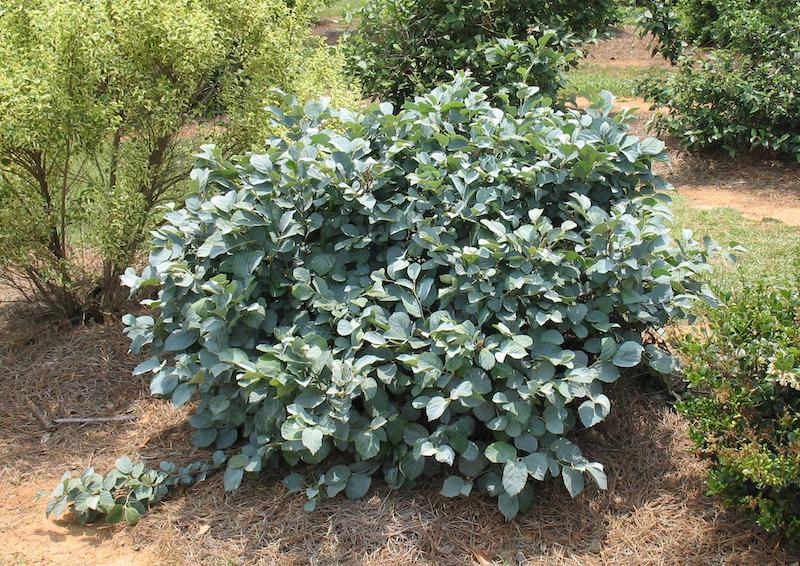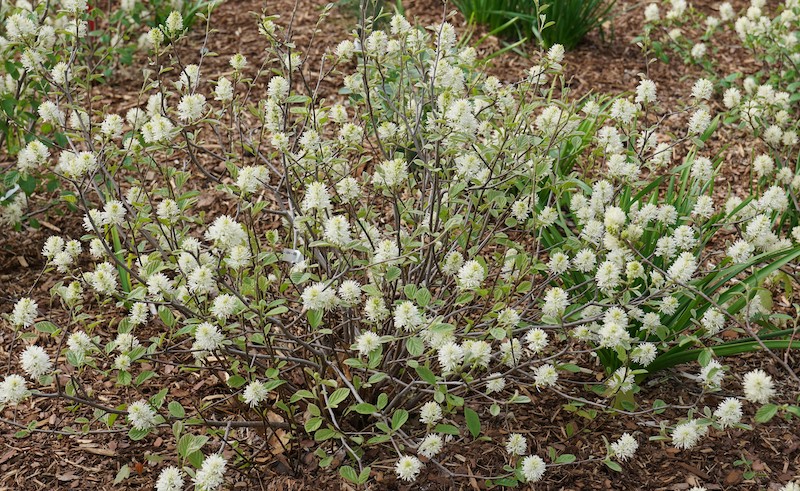Fothergilla is a genus of plants in the witch hazel family containing two well-known species of shrubs. Also known as witch alder, fothergilla provides four seasons of interest, including white bottlebrush flowers in spring, and gold, burgundy, and orange leaves in fall. In the landscape, fothergilla pairs well with other acidic-loving shrubs such as rhododendrons and hydrangeas. These deciduous shrubs look lovely in mass plantings, mixed borders, and woodland edges. With proper site preparation and care, you can grow healthy, beautiful fothergilla shrubs.

What You Need To Plant Fothergilla
- Shovel
- Organic matter, such as compost
- Hose
- Mulch
- Garden fork
Where to Plant Fothergilla
Plant fothergilla in well-drained soil that is rich in organic matter. This shrub needs to grow in acidic soil with a pH of 5-6.5. If a soil test determines that your soil is too alkaline, incorporate pH-reducing products such as aluminum sulfate or ericaceous compost into the soil. Fothergilla can be planted in full sun or partial shade. More sun will produce a better flower and fall color display, but afternoon shade will reduce stress on the plant during hot, dry summers. Plant fothergilla deep enough so that its root collar rests just above the soil line. The root collar can be identified as the flared area where the trunk meets the roots.
Fothergilla Spacing
Since there is great variation in size amongst fothergillas, spacing depends on the species. Space plants according to their maximum width at maturity to give them ample room to grow. Dwarf fothergilla, F. gardenii, grows to just 2-5 feet tall and wide, whereas large fothergilla, F. major, can grow and spread to 6-10 feet. Dwarf fothergilla can be planted closer to buildings and other plants than large or hybrid fothergillas. Numerous hybrids of these two species exist and can be planted about 4-6 feet apart. These shallow-rooted shrubs grow fairly well with neighboring plants, but they may spread via suckers. The suckers, which are shoots arising from the base of the shrub, can invade garden beds if left unchecked. Prune out suckers to control the spread of fothergilla.

Steps To Plant Fothergilla
Step 1 - If your soil is compacted or alkaline, you will need to incorporate organic matter into the soil to improve drainage and reduce the pH. Apply a 1-2 inch layer of acidic organic matter, such as ericaceous compost, on top of the soil where the fothergilla will be planted. Using a garden fork, turn the soil over so that the organic matter and native soil are blended a few inches deep.
Step 2 - Using a shovel, dig a hole that is 2 times as wide as the plant’s container and deep enough for the root collar to rest even with the soil line. Place the fothergilla into the hole and backfill with soil.
Step 3 - Water the shrub with a hose immediately after planting. Keep the soil consistently moist for newly planted fothergilla by watering weekly for at least the first growing season.
Step 4 - To insulate the soil and conserve moisture, apply 2-3 inches of wood-based mulch over the top of the soil. Spread the mulch above the root zone, avoiding contact with the plant’s bark.
When to Plant Fothergilla
The best time to plant fothergilla is in the fall during the morning or on an overcast day. This allows plenty of time for the roots to establish before summer and results in less water loss from transpiration in hot temperatures. If you are unable to plant fothergilla in fall, spring is also a good time for planting. The mild conditions of spring and fall reduce the likelihood of transplant shock and encourage quick, healthy establishment. Avoid planting fothergilla in winter or summer when the weather is less than ideal for root development.
Transplanting Fothergilla
Fothergilla are shallow-rooted and slow-growing plants that take well to transplanting. Carefully dig a circle around the plant and lift it from the ground, retaining as much of the root system and original soil as possible. Plant it in a space that accommodates the root system. Water deeply after planting. Always transplant fothergilla in fall or spring to give them the best chance for survival and establishment. Older, larger fothergillas may be more difficult to transplant than younger, smaller, or dwarf fothergillas.
Fothergilla is also easily propagated by softwood cuttings in summer. Snip a cutting from a sucker at the base of the plant. Be sure the cutting has about 3 or 4 nodes, which is where the leaves originate. Use a rooting hormone for a greater success rate. Plant the cutting in a pot with a peat- and perlite-based potting soil. Allow the cuttings to root with visible new growth before planting them out.
 |
Lauren Youngcourt - Published 06-24-2023 |
